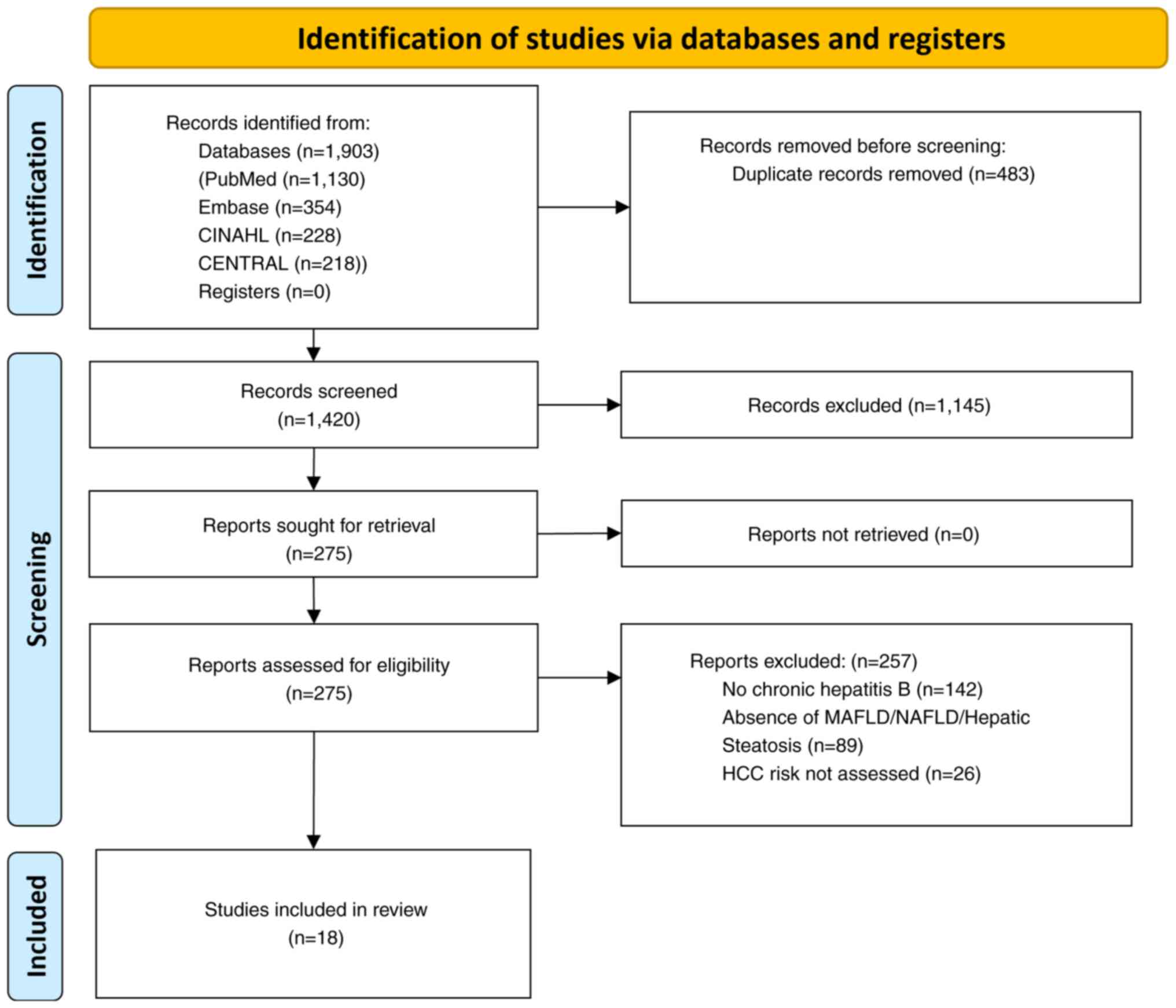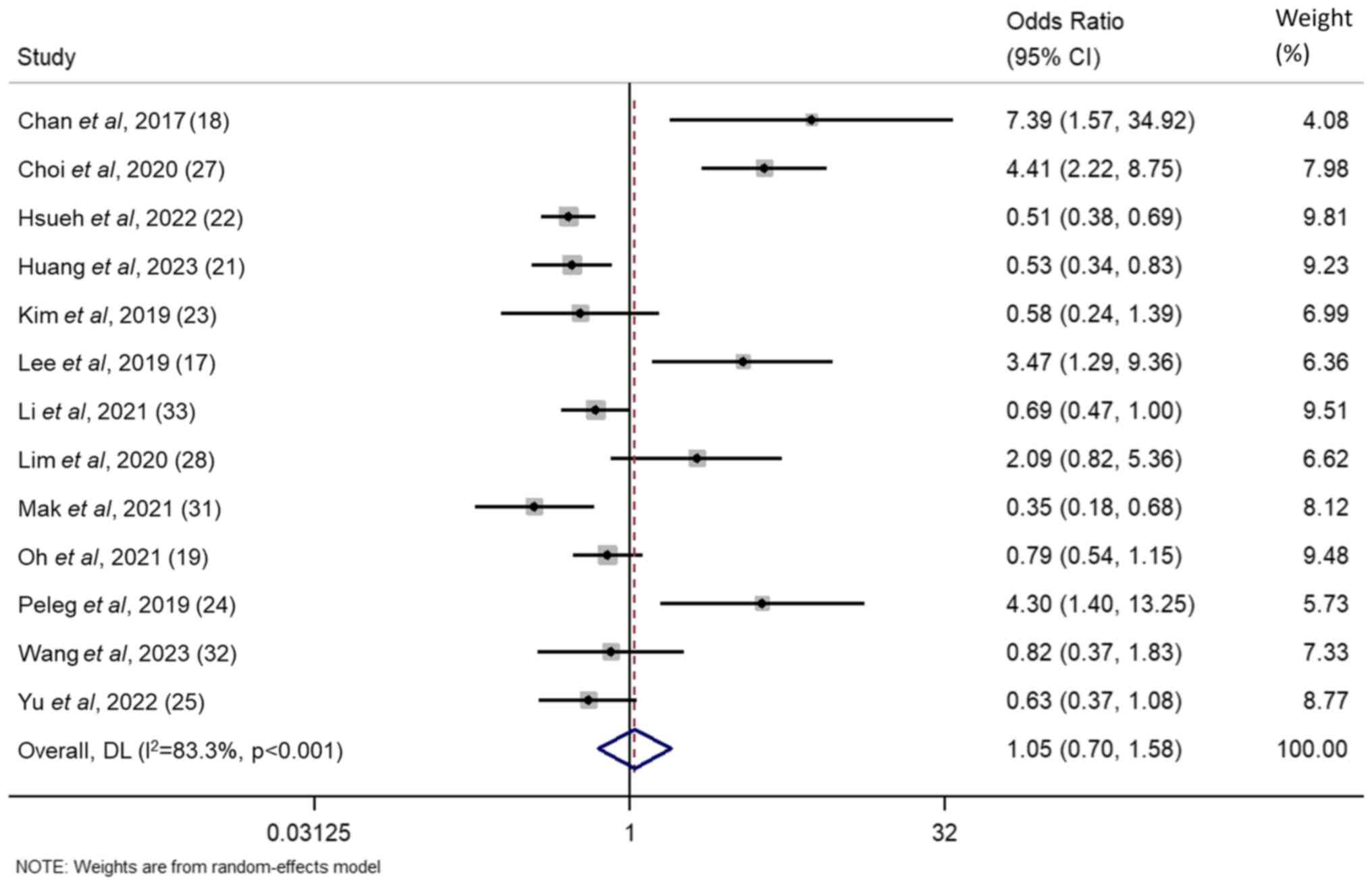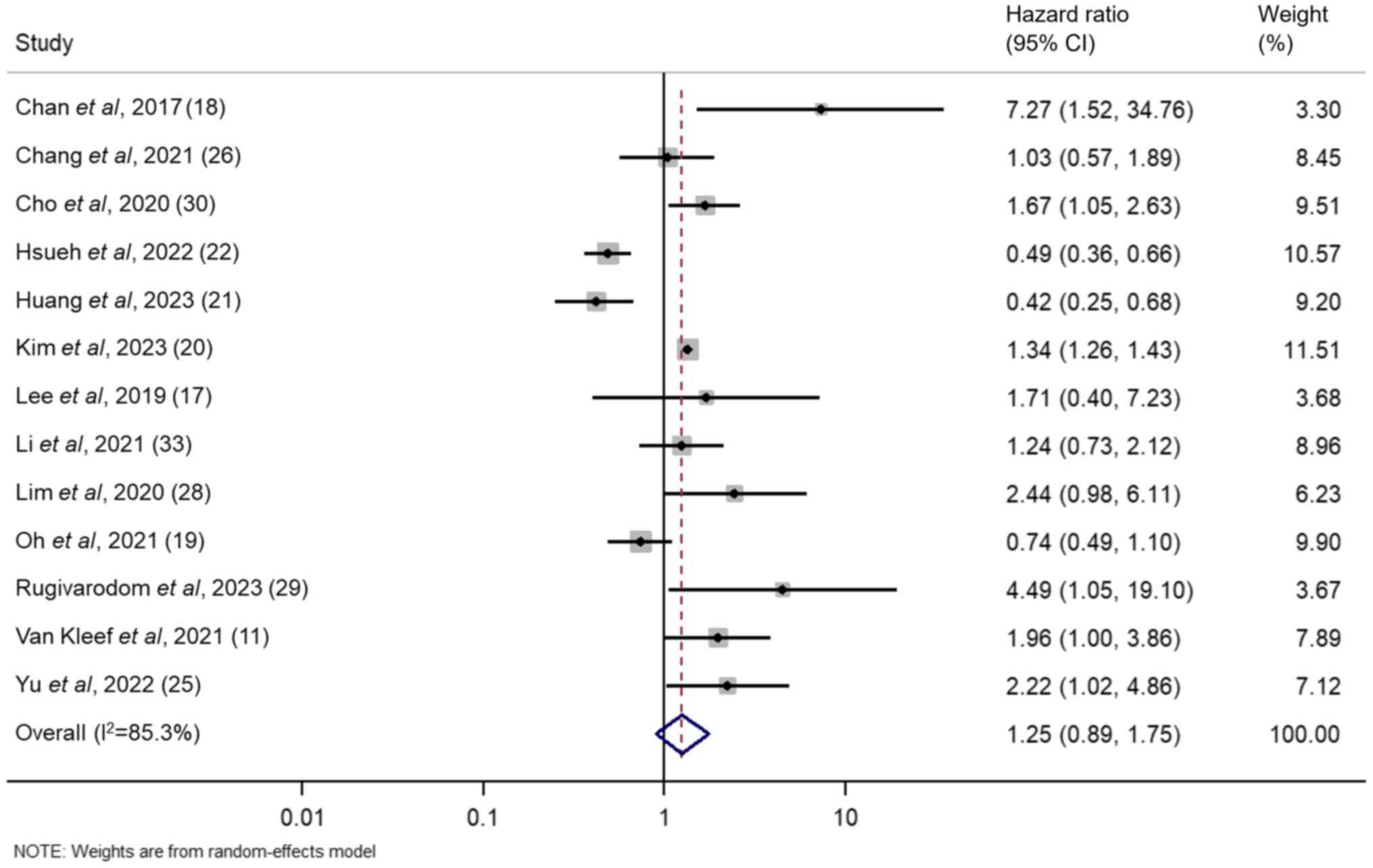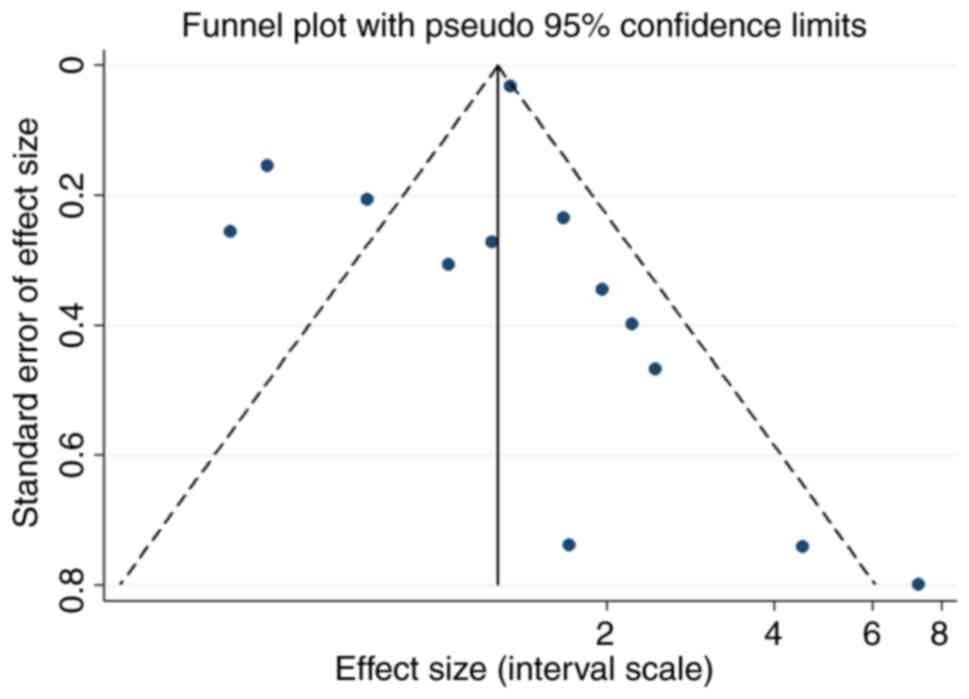|
1
|
Chidambaranathan-Reghupaty S, Fisher PB
and Sarkar D: Hepatocellular carcinoma (HCC): Epidemiology,
etiology and molecular classification. Adv Cancer Res. 149:1–61.
2021.PubMed/NCBI View Article : Google Scholar
|
|
2
|
Kulik L and El-Serag HB: Epidemiology and
management of hepatocellular carcinoma. Gastroenterology.
156:477–491.e1. 2019.PubMed/NCBI View Article : Google Scholar
|
|
3
|
Rapti I and Hadziyannis S: Risk for
hepatocellular carcinoma in the course of chronic hepatitis B virus
infection and the protective effect of therapy with nucleos(t)ide
analogu. World J Hepatol. 7:1064–1073. 2015.PubMed/NCBI View Article : Google Scholar
|
|
4
|
Brody H: Hepatitis B. Nature.
603(S45)2022.PubMed/NCBI View Article : Google Scholar
|
|
5
|
El-Serag HB: Epidemiology of viral
hepatitis and hepatocellular carcinoma. Gastroenterology.
142:1264–1273.e1. 2012.PubMed/NCBI View Article : Google Scholar
|
|
6
|
Krump NA and You J: Molecular mechanisms
of viral oncogenesis in humans. Nat Rev Microbiol. 16:684–698.
2018.PubMed/NCBI View Article : Google Scholar
|
|
7
|
Mui UN, Haley CT and Tyring SK: Viral
oncology: Molecular biology and pathogenesis. J Clin Med.
6(111)2017.PubMed/NCBI View Article : Google Scholar
|
|
8
|
Pouwels S, Sakran N, Graham Y, Leal A,
Pintar T, Yang W, Kassir R, Singhal R, Mahawar K and Ramnarain D:
Non-alcoholic fatty liver disease (NAFLD): A review of
pathophysiology, clinical management and effects of weight loss.
BMC Endocr Disord. 22(63)2022.PubMed/NCBI View Article : Google Scholar
|
|
9
|
Pipitone RM, Ciccioli C, Infantino G, La
Mantia C, Parisi S, Tulone A, Pennisi G, Grimaudo S and Petta S:
MAFLD: A multisystem disease. Ther Adv Endocrinol Metab.
14(20420188221145549)2023.PubMed/NCBI View Article : Google Scholar
|
|
10
|
Wang X and Xie Q: Metabolic
dysfunction-associated fatty liver disease (MAFLD) and viral
hepatitis. J Clin Transl Hepatol. 10:128–133. 2022.PubMed/NCBI View Article : Google Scholar
|
|
11
|
van Kleef LA, Choi HSJ, Brouwer WP, Hansen
BE, Patel K, de Man RA, Janssen HLA, de Knegt RJ and Sonneveld MJ:
Metabolic dysfunction-associated fatty liver disease increases risk
of adverse outcomes in patients with chronic hepatitis B. JHEP Rep.
3(100350)2021.PubMed/NCBI View Article : Google Scholar
|
|
12
|
Chen X, Zhou J, Wu L, Zhu X and Deng H:
MAFLD is associated with the risk of liver fibrosis and
inflammatory activity in HBeAg-negative CHB patients. Diabetes
Metab Syndr Obes. 15:673–683. 2022.PubMed/NCBI View Article : Google Scholar
|
|
13
|
Page MJ, McKenzie JE, Bossuyt PM, Boutron
I, Hoffmann TC, Mulrow CD, Shamseer L, Tetzlaff JM, Akl EA, Brennan
SE, et al: The PRISMA 2020 statement: An updated guideline for
reporting systematic reviews. BMJ. 372(n71)2021.PubMed/NCBI View
Article : Google Scholar
|
|
14
|
Lo CKL, Mertz D and Loeb M:
Newcastle-Ottawa Scale: Comparing reviewers' to authors'
assessments. BMC Med Res Methodol. 14(45)2014.PubMed/NCBI View Article : Google Scholar
|
|
15
|
Cumpston M, Li T, Page MJ, Chandler J,
Welch VA, Higgins JP and Thomas J: Updated guidance for trusted
systematic reviews: A new edition of the cochrane handbook for
systematic reviews of interventions. Cochrane Database Syst Rev.
10(ED000142)2019.PubMed/NCBI View Article : Google Scholar
|
|
16
|
Kirmayr M, Quilodrán C, Valente B, Loezar
C, Garegnani L and Franco JVA: The GRADE approach, Part 1: How to
assess the certainty of the evidence. Medwave.
21(e8109)2021.PubMed/NCBI View Article : Google Scholar
|
|
17
|
Lee YB, Ha Y, Chon YE, Kim MN, Lee JH,
Park H, Kim KI, Kim SH, Rim KS and Hwang SG: Association between
hepatic steatosis and the development of hepatocellular carcinoma
in patients with chronic hepatitis B. Clin Mol Hepatol. 25:52–64.
2019.PubMed/NCBI View Article : Google Scholar
|
|
18
|
Chan AWH, Wong GLH, Chan HY, Tong JHM, Yu
YH, Choi PCL, Chan HLY, To KF and Wong VWS: Concurrent fatty liver
increases risk of hepatocellular carcinoma among patients with
chronic hepatitis B. J Gastroenterol Hepatol. 32:667–676.
2017.PubMed/NCBI View Article : Google Scholar
|
|
19
|
Oh JH, Lee HW, Sinn DH, Park JY, Kim BK,
Kim SU, Kim DY, Ahn SH, Kang W, Gwak GY, et al: Controlled
attenuation parameter value and the risk of hepatocellular
carcinoma in chronic hepatitis B patients under antiviral therapy.
Hepatol Int. 15:892–900. 2021.PubMed/NCBI View Article : Google Scholar
|
|
20
|
Kim MN, Han K, Yoo J, Hwang SG, Zhang X
and Ahn SH: Diabetic MAFLD is associated with increased risk of
hepatocellular carcinoma and mortality in chronic viral hepatitis
patients. Int J Cancer. 153:1448–1458. 2023.PubMed/NCBI View Article : Google Scholar
|
|
21
|
Huang SC, Su TH, Tseng TC, Chen CL, Hsu
SJ, Liao SH, Hong CM, Liu CH, Lan TY, Yang HC, et al: Distinct
effects of hepatic steatosis and metabolic dysfunction on the risk
of hepatocellular carcinoma in chronic hepatitis B. Hepatol Int.
17:1139–1149. 2023.PubMed/NCBI View Article : Google Scholar
|
|
22
|
Hsueh RC, Wu WJ, Lin CL, Liu CJ, Huang YW,
Hu JT, Wu CF, Sung FY, Liu WJ and Yu MW: Impact of PNPLA3 p. I148M
and hepatic steatosis on long-term outcomes for hepatocellular
carcinoma and HBsAg seroclearance in chronic hepatitis B. J
Hepatocell Carcinoma. 9:301–313. 2022.PubMed/NCBI View Article : Google Scholar
|
|
23
|
Kim DS, Jeon MY, Lee HW, Kim BK, Park JY,
Kim DY, Ahn SH, Han KH and Kim SU: Influence of hepatic steatosis
on the outcomes of patients with chronic hepatitis B treated with
entecavir and tenofovir. Clin Mol Hepatol. 25:283–293.
2019.PubMed/NCBI View Article : Google Scholar
|
|
24
|
Peleg N, Issachar A, Sneh Arbib O,
Cohen-Naftaly M, Braun M, Leshno M, Barsheshet A and Shlomai A:
Liver steatosis is a strong predictor of mortality and cancer in
chronic hepatitis B regardless of viral load. JHEP Rep. 1:9–16.
2019.PubMed/NCBI View Article : Google Scholar
|
|
25
|
Yu MW, Lin CL, Liu CJ, Wu WJ, Hu JT and
Huang YW: Metabolic-associated fatty liver disease, hepatitis B
surface antigen seroclearance, and long-term risk of hepatocellular
carcinoma in chronic hepatitis B. Cancers (Basel).
14(6012)2022.PubMed/NCBI View Article : Google Scholar
|
|
26
|
Chang JW, Lee JS, Lee HW, Kim BK, Park JY,
Kim DY, Ahn SH and Kim SU: No influence of hepatic steatosis on the
3-year outcomes of patients with quiescent chronic hepatitis B. J
Viral Hepat. 28:1545–1553. 2021.PubMed/NCBI View Article : Google Scholar
|
|
27
|
Choi HSJ, Brouwer WP, Zanjir WMR, de Man
RA, Feld JJ, Hansen BE, Janssen HLA and Patel K: Nonalcoholic
steatohepatitis is associated with liver-related outcomes and
all-cause mortality in chronic hepatitis B. Hepatology. 71:539–548.
2020.PubMed/NCBI View Article : Google Scholar
|
|
28
|
Lim CT, Goh GBB, Li H, Lim TK, Leow WQ,
Wan WK, Azhar R, Chow WC and Kumar R: Presence of hepatic steatosis
does not increase the risk of hepatocellular carcinoma in patients
with chronic hepatitis b over long follow-Up. Microbiol Insights.
13(1178636120918878)2020.PubMed/NCBI View Article : Google Scholar
|
|
29
|
Rugivarodom M, Pongpaibul A, Chainuvati S,
Nimanong S, Chotiyaputta W, Tanwandee T and Charatcharoenwitthaya
P: Prognostic relevance of metabolic dysfunction-associated
steatohepatitis for patients with chronic hepatitis B. J Clin
Transl Hepatol. 11:76–87. 2023.PubMed/NCBI View Article : Google Scholar
|
|
30
|
Cho H, Chang Y, Lee JH, Cho YY, Nam JY,
Lee YB, Lee DH, Cho EJ, Yu SJ, Kim YJ, et al: Radiologic
nonalcoholic fatty liver disease increases the risk of
hepatocellular carcinoma in patients with suppressed chronic
hepatitis B. J Clin Gastroenterol. 54:633–641. 2020.PubMed/NCBI View Article : Google Scholar
|
|
31
|
Mak LY, Hui RWH, Fung J, Liu F, Wong DK,
Li B, Cheung KS, Yuen MF and Seto WK: Reduced hepatic steatosis is
associated with higher risk of hepatocellular carcinoma in chronic
hepatitis B infection. Hepatol Int. 15:901–911. 2021.PubMed/NCBI View Article : Google Scholar
|
|
32
|
Wang X, Wei S, Wei Y, Wang X, Xiao F, Feng
Y and Zhu Q: The impact of concomitant metabolic
dysfunction-associated fatty liver disease on adverse outcomes in
patients with hepatitis B cirrhosis: A propensity score matching
study. Eur J Gastroenterol Hepatol. 35:889–898. 2023.PubMed/NCBI View Article : Google Scholar
|
|
33
|
Li J, Yang HI, Yeh ML, Le MH, Le AK, Yeo
YH, Dai CY, Barnett S, Zhang JQ, Huang JF, et al: Association
between fatty liver and cirrhosis, hepatocellular carcinoma, and
hepatitis b surface antigen seroclearance in chronic hepatitis B. J
Infect Dis. 224:294–302. 2021.PubMed/NCBI View Article : Google Scholar
|
|
34
|
Petrescu M, Vlaicu SI, Ciumărnean L,
Milaciu MV, Mărginean C, Florea M, Vesa ȘC and Popa M: Chronic
inflammation-A link between nonalcoholic fatty liver disease
(NAFLD) and dysfunctional adipose tissue. Medicina (Kaunas).
58(641)2022.PubMed/NCBI View Article : Google Scholar
|
|
35
|
Chen J, Deng X, Liu Y, Tan Q, Huang G, Che
Q, Guo J and Su Z: Kupffer cells in non-alcoholic fatty liver
disease: Friend or foe? Int J Biol Sci. 16:2367–2378.
2020.PubMed/NCBI View Article : Google Scholar
|
|
36
|
Sakurai Y, Kubota N, Yamauchi T and
Kadowaki T: Role of insulin resistance in MAFLD. Int J Mol Sci.
22(4156)2021.PubMed/NCBI View Article : Google Scholar
|
|
37
|
Ma Y, Lee G, Heo SY and Roh YS: Oxidative
stress is a key modulator in the development of nonalcoholic fatty
liver disease. Antioxidants (Basel). 11(91)2021.PubMed/NCBI View Article : Google Scholar
|
|
38
|
Zorena K, Jachimowicz-Duda O, Ślęzak D,
Robakowska M and Mrugacz M: Adipokines and obesity. Potential link
to metabolic disorders and chronic complications. Int J Mol Sci.
21(3570)2020.PubMed/NCBI View Article : Google Scholar
|
|
39
|
Brenner DA, Paik YH and Schnabl B: Role of
gut microbiota in liver disease. J Clin Gastroenterol. 49 (Suppl
1):S25–S27. 2015.PubMed/NCBI View Article : Google Scholar
|
|
40
|
Kountouras J, Kazakos E, Kyrailidi F,
Polyzos SA, Zavos C, Arapoglou S, Boziki M, Mouratidou MC,
Tzitiridou-Chatzopoulou M, Chatzopoulos D, et al: Innate immunity
and nonalcoholic fatty liver disease. Ann Gastroenterol.
36:244–256. 2023.PubMed/NCBI View Article : Google Scholar
|
|
41
|
Duncan AW, Dorrell C and Grompe M: Stem
cells and liver regeneration. Gastroenterology. 137:466–481.
2009.PubMed/NCBI View Article : Google Scholar
|
|
42
|
Ipsen DH, Lykkesfeldt J and Tveden-Nyborg
P: Molecular mechanisms of hepatic lipid accumulation in
non-alcoholic fatty liver disease. Cell Mol Life Sci. 75:3313–3327.
2018.PubMed/NCBI View Article : Google Scholar
|
|
43
|
Severson TJ, Besur S and Bonkovsky HL:
Genetic factors that affect nonalcoholic fatty liver disease: A
systematic clinical review. World J Gastroenterol. 22:6742–6756.
2016.PubMed/NCBI View Article : Google Scholar
|


















